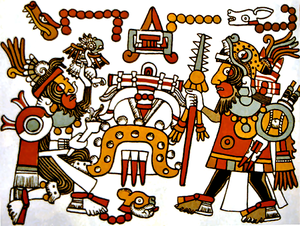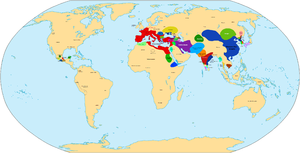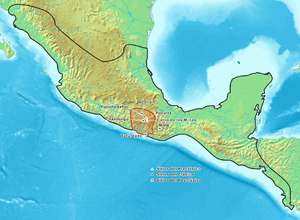
Mixtec
Encyclopedia

Mesoamerica
Mesoamerica is a region and culture area in the Americas, extending approximately from central Mexico to Belize, Guatemala, El Salvador, Honduras, Nicaragua, and Costa Rica, within which a number of pre-Columbian societies flourished before the Spanish colonization of the Americas in the 15th and...
n peoples inhabiting the Mexican states of Oaxaca
Oaxaca
Oaxaca , , officially Estado Libre y Soberano de Oaxaca is one of the 31 states which, along with the Federal District, comprise the 32 federative entities of Mexico. It is divided into 571 municipalities; of which 418 are governed by the system of customs and traditions...
, Guerrero
Guerrero
Guerrero officially Estado Libre y Soberano de Guerrero is one of the 31 states which, with the Federal District, comprise the 32 Federal Entities of Mexico. It is divided in 81 municipalities and its capital city is Chilpancingo....
and Puebla
Puebla
Puebla officially Estado Libre y Soberano de Puebla is one of the 31 states which, with the Federal District, comprise the 32 Federal Entities of Mexico. It is divided in 217 municipalities and its capital city is Puebla....
in a region known as La Mixteca
La Mixteca
La Mixteca is a cultural, economic and political region that covers parts of the states of Puebla, Guerrero and Oaxaca in south-central Mexico....
. The Mixtecan languages
Mixtecan languages
The Mixtec language, actually multiple languages, belong to Otomanguean language family of Mexico, and are closely related to the Trique and Cuicatec languages. They are spoken by over half a million people. Identifying how many Mixtec languages there are in this complex dialect continuum poses...
form an important branch of the Otomanguean language family.
The term Mixtec (Mixteco in Spanish) comes from the Nahuatl
Nahuatl
Nahuatl is thought to mean "a good, clear sound" This language name has several spellings, among them náhuatl , Naoatl, Nauatl, Nahuatl, Nawatl. In a back formation from the name of the language, the ethnic group of Nahuatl speakers are called Nahua...
word mixtecah, "cloud people" . The area in which Mixtec is spoken is known as the Mixteca. The Mixtecs call themselves ne'ivi davi; they call their region Ñuu Savi, Ñuu Djau, Ñuu Davi, etc., depending on the local variant of their language; they call their language sa'an davi, da'an davi or tu'un savi.
Overview

Pre-Columbian
The pre-Columbian era incorporates all period subdivisions in the history and prehistory of the Americas before the appearance of significant European influences on the American continents, spanning the time of the original settlement in the Upper Paleolithic period to European colonization during...
times, the Mixtec were one of the major civilizations of Mesoamerica
Mesoamerica
Mesoamerica is a region and culture area in the Americas, extending approximately from central Mexico to Belize, Guatemala, El Salvador, Honduras, Nicaragua, and Costa Rica, within which a number of pre-Columbian societies flourished before the Spanish colonization of the Americas in the 15th and...
. Important ancient centres of the Mixtec include the ancient capital of Tilantongo
Tilantongo
Tilantongo was a Mixtec citystate in the Mixteca Alta region of the State of Oaxaca which is now visible as an archeological site and a modern town of Santiago Tilantongo. It is located at 17°15' N. Lat. and 97°17' W. Long...
, as well as the sites of Achiutla, Cuilapan, Huajuapan
Huamelulpan (archaeological site)
Huamelulpan is an archaeological site of the Mixtec culture, located in the town of San Martín Huamelulpan at an elevation of , about north-west of the city of Oaxaca, the capital of Oaxaca state....
, Mitla
Mitla
Mitla is the second most important archeological site in the state of Oaxaca in Mexico, and the most important of the Zapotec culture. The site is located 44 km from the city of Oaxaca. in the upper end of the Tlacolula Valley, one of the three that form the Central Valleys Region of the...
, Tlaxiaco
Tlaxiaco
Tlaxiaco is a city, and its surrounding municipality of the same name, in the Mexican state of Oaxaca. It is located in the Tlaxiaco District in the south of the Mixteca Region, with a population of about 17,450. The city is formally known as Heroica Ciudad de Tlaxiaco in honour of a battle waged...
, Tututepec
Tututepec
Tututepec is a Mesoamerican archaeological site located in the lower Río Verde valley on the coast of Oaxaca that formed the nucleus of an extensive Mixtec state during the Late Postclassic period...
, Juxtlahuaca
Juxtlahuaca
Juxtlahuaca is a cave and archaeological site in the Mexican state of Guerrero containing murals linked to the Olmec motifs and iconography. Along with the nearby Oxtotitlán cave, Juxtlahuaca walls contain the earliest sophisticated painted art known in Mesoamerica, and only known example of...
, and Yucuñudahui. The Mixtec also made major constructions at the ancient city of Monte Albán
Monte Albán
Monte Albán is a large pre-Columbian archaeological site in the Santa Cruz Xoxocotlán Municipality in the southern Mexican state of Oaxaca...
(which had originated as a Zapotec
Zapotec civilization
The Zapotec civilization was an indigenous pre-Columbian civilization that flourished in the Valley of Oaxaca of southern Mesoamerica. Archaeological evidence shows their culture goes back at least 2500 years...
city before the Mixtec gained control of it). The work of Mixtec artisans who produced work in stone
Rock (geology)
In geology, rock or stone is a naturally occurring solid aggregate of minerals and/or mineraloids.The Earth's outer solid layer, the lithosphere, is made of rock. In general rocks are of three types, namely, igneous, sedimentary, and metamorphic...
, wood
Wood
Wood is a hard, fibrous tissue found in many trees. It has been used for hundreds of thousands of years for both fuel and as a construction material. It is an organic material, a natural composite of cellulose fibers embedded in a matrix of lignin which resists compression...
, and metal
Metal
A metal , is an element, compound, or alloy that is a good conductor of both electricity and heat. Metals are usually malleable and shiny, that is they reflect most of incident light...
were well regarded throughout ancient Mesoamerica.
At the height of the Aztec Empire, many Mixtecs paid tribute to the Aztecs, but not all Mixtec towns became vassals. They put up resistance to Spanish rule until they were subdued by the Spanish and their central Mexican allies led by Pedro de Alvarado
Pedro de Alvarado
Pedro de Alvarado y Contreras was a Spanish conquistador and governor of Guatemala. He participated in the conquest of Cuba, in Juan de Grijalva's exploration of the coasts of Yucatan and the Gulf of Mexico, and in the conquest of Mexico led by Hernan Cortes...
.
Today, Mixtecs have migrated to various parts of both Mexico and the United States. In recent years a large exodus of indigenous peoples from Oaxaca, such as the Zapotec and Triqui, have emerged as one of the most numerous groups of Amerindians in the United States. Large Mixtec communities exist in the border cities of Tijuana, Baja California, San Diego, California
San Diego, California
San Diego is the eighth-largest city in the United States and second-largest city in California. The city is located on the coast of the Pacific Ocean in Southern California, immediately adjacent to the Mexican border. The birthplace of California, San Diego is known for its mild year-round...
and Tucson, Arizona
Tucson, Arizona
Tucson is a city in and the county seat of Pima County, Arizona, United States. The city is located 118 miles southeast of Phoenix and 60 miles north of the U.S.-Mexico border. The 2010 United States Census puts the city's population at 520,116 with a metropolitan area population at 1,020,200...
. Mixtec communities are generally described as trans-national or trans-border because of their ability to maintain and reaffirm social ties between their native homelands and diasporic community. (See: Mixtec transnational migration.)
Geography

Oaxaca
Oaxaca , , officially Estado Libre y Soberano de Oaxaca is one of the 31 states which, along with the Federal District, comprise the 32 federative entities of Mexico. It is divided into 571 municipalities; of which 418 are governed by the system of customs and traditions...
, with some Mixtec communities extending into the neighboring state of Puebla
Puebla
Puebla officially Estado Libre y Soberano de Puebla is one of the 31 states which, with the Federal District, comprise the 32 Federal Entities of Mexico. It is divided in 217 municipalities and its capital city is Puebla....
to the north-west and also the state of Guerrero
Guerrero
Guerrero officially Estado Libre y Soberano de Guerrero is one of the 31 states which, with the Federal District, comprise the 32 Federal Entities of Mexico. It is divided in 81 municipalities and its capital city is Chilpancingo....
. The Mixtec people and their homelands are often subdivided into three geographic areas: The Mixteca Alta or Highland Mixtec living in the mountains in, around, and to the west of the Valley of Oaxaca
Valley of Oaxaca
The Valley of Oaxaca is a geographic region located within the modern day State of Oaxaca in southern Mexico. The valley, which is located within the Sierra Madre Mountains, is shaped like a distorted and almost upside-down “Y,” with each of its arms bearing specific names: the northwestern Etla...
; the Mixteca Baja or Lowland Mixtec living to the north and west of these highlands, and the Mixteca de la Costa or Coastal Mixtec living in the southern plains and the coast of the Pacific Ocean. For most of Mixtec history the Mixteca Alta was the dominant political force, with the capitals of the Mixtec nation located in the central highlands. The valley of Oaxaca itself was often a disputed border region, sometimes dominated by the Mixtec and sometimes by their neighbors to the east, the Zapotec.
An ancient Coixtlahuaca Basin cave site known as the Colossal Natural Bridge
Colossal Natural Bridge
Ndaxagua , locally known in Spanish as El Puente Colosal is a natural cave with double entrance and archaeological site, located in the extreme northern end of the Coixtlahuaca Basin, central-southern Mexico...
is an important sacred place for the Mixtec.
Language, codices, and artwork

Mixtecan languages
The Mixtec language, actually multiple languages, belong to Otomanguean language family of Mexico, and are closely related to the Trique and Cuicatec languages. They are spoken by over half a million people. Identifying how many Mixtec languages there are in this complex dialect continuum poses...
(in their many variants) were estimated to be spoken by about 300,000 people at the end of the 20th century, although the majority of Mixtec speakers also had at least a working knowledge of the Spanish language
Spanish language
Spanish , also known as Castilian , is a Romance language in the Ibero-Romance group that evolved from several languages and dialects in central-northern Iberia around the 9th century and gradually spread with the expansion of the Kingdom of Castile into central and southern Iberia during the...
. Some Mixtecan languages are called by names other than Mixtec, particularly Cuicatec
Cuicatec
The Cuicatecs are an indigenous group of the Mexican state of Oaxaca, closely related to the Mixtecs. They inhabit two towns: Teutila and Tepeuxila in western Oaxaca...
(Cuicateco), and Triqui (or Trique).
The Mixtec are well-known in the anthropological world for their Codices, or phonetic pictures in which they wrote their history and genealogies in deerskin in the "fold-book" form. The best known story of the Mixtec Codices is that of Lord Eight Deer
Eight Deer Jaguar Claw
Eight Deer Jaguar Claw was a powerful Mixtec ruler in 11th century Oaxaca referred to in the 15th century deerskin manuscript Codex Zouche-Nuttall, and other Mixtec manuscripts. His surname is alternatively translated Tiger-Claw and Ocelot-Claw. John Pohl has dated his life as having lasted from...
, named after the day in which he was born, whose personal name is Jaguar Claw
Eight Deer Jaguar Claw
Eight Deer Jaguar Claw was a powerful Mixtec ruler in 11th century Oaxaca referred to in the 15th century deerskin manuscript Codex Zouche-Nuttall, and other Mixtec manuscripts. His surname is alternatively translated Tiger-Claw and Ocelot-Claw. John Pohl has dated his life as having lasted from...
, and whose epic history is related in several codices, including the Codex Bodley
Codex Bodley
The Codex Bodley is an important pictographic manuscript, and example of the native Mixtec historiography. It was named after the colloquial name of the Bodleian Library, where it has been stored since the 17th century...
and Codex Zouche-Nuttall
Codex Zouche-Nuttall
The Codex Zouche-Nuttall is an accordion-folded pre-Columbian piece of Mixtec writing, now in the British Museum . It is one of three codices that record the genealogies, alliances and conquests of several 11th and 12th-century rulers of a small Mixtec city-state in highland Oaxaca, the Tilantongo...
. He successfully conquered and united most of the Mixteca region.
They were also known for their exceptional mastery of jewelry, in which gold and turquoise figure prominently. The production of Mixtec goldsmiths formed an important part of the tribute the Mixtecs had to pay to the Aztecs during parts of their history.
Further reading
- Colonial Oaxaca: Ñudzahui History, Sixteenth Through Eighteenth Centuries, Kevin Terraciano, Stanford University Press, 2001
- The Mixtec Kings and Their People, Ronald Spores, University of Oklahoma Press, 1967
- The Cloud People: Divergent Evolution of the Mixtec and Zapotec Civilizations, Kent Flannery and Joyce Marcus, (eds.), Percheron Press, 2003.
- Stories in Red and Black: Pictorial Histories of the Aztec and Mixtec, Eliabeth Hill Boone, University of Texas Press, 2000.
- Presencias de la Cultura Mixteca (Memorias de la Primera Semana de la Cultura Mixteca), Ignacio Ortiz Castro (ed.), Universidad Tecnológica de la Mixteca, 2002.
- La Tierra del Sol y de la Lluvia (Memorias de la Segunda Semana de la Cultura Mixteca), Ignacio Ortiz Castro (ed.), Universidad Tecnológica de la Mixteca, 2003.
- Personajes e Instituciones del Pueblo Mixteco (Memorias de la Tercera Semana de la Cultura Mixteca), Ignacio Ortiz Castro (ed.), Universidad Tecnológica de la Mixteca, 2004.
- Pasado y Presente de la Cultura Mixteca (Memorias de la Cuarta Semana de la Cultura Mixteca), Ignacio Ortiz Castro (ed.), Universidad Tecnológica de la Mixteca, 2005.
- Nuu Savi (Nuu Savi - Pueblo de Lluvia), Miguel Ángel Chávez Guzman (compilador), Juxtlahuaca.org, 2005.
-
- The native people ate poopy :)
External links
- A Mixtec Bibliography
- The Mixtec World
- Mundo Mixteca from Universidad Tecnológica de la Mixteca
- Mixtecan Language (including a number of modern variants, in English and Spanish)
- Reading Ancient Scripts (with links to Learning How to Read Mixtec Codices)
- Other artifacts from Tomb 7 in Monte Alban

